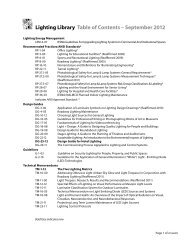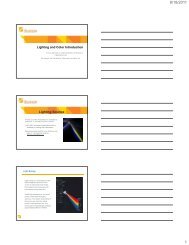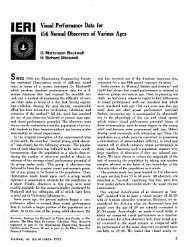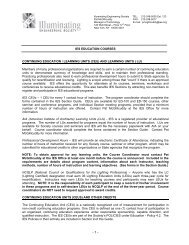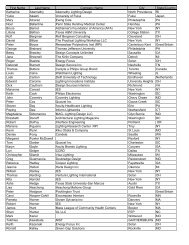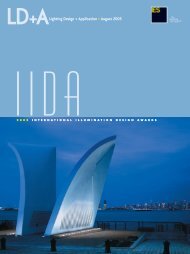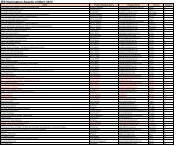faces of the future - Illuminating Engineering Society
faces of the future - Illuminating Engineering Society
faces of the future - Illuminating Engineering Society
You also want an ePaper? Increase the reach of your titles
YUMPU automatically turns print PDFs into web optimized ePapers that Google loves.
RESEARCH MATTERS<br />
with workstation-specific luminaires<br />
had higher ceiling luminances than<br />
<strong>the</strong> parabolic-louvered luminaire<br />
spaces; those with high-reflectance<br />
furnishings also had higher vertical<br />
luminances in <strong>the</strong> field <strong>of</strong> view.<br />
QUESTIONNAIRE RESULTS<br />
The questionnaire revealed <strong>the</strong><br />
following. Detailed results are available<br />
in <strong>the</strong> project report (Veitch,<br />
Newsham, Mancini, & Arsenault,<br />
2010, in press) on <strong>the</strong> Light Right<br />
(www.lightright.org) and NRC<br />
(www.nrc-cnrc.gc.ca) websites.<br />
Workstation-specific lighting with<br />
individual control is <strong>the</strong> higher-quality<br />
lighting solution. Workstationspecific<br />
lighting with individual<br />
(personal) control was preferred<br />
over parabolic-louvered luminaires<br />
regardless <strong>of</strong> <strong>the</strong> surface reflectances<br />
<strong>of</strong> <strong>the</strong> furnishings. The workstationspecific<br />
luminaires were rated as providing<br />
lighting that was better than<br />
in o<strong>the</strong>r similar workplaces; <strong>the</strong> parabolic-louvered<br />
luminaires were seen<br />
as being <strong>the</strong> same as in o<strong>the</strong>r similar<br />
workplaces. In <strong>the</strong> most sensitive statistical<br />
tests, small effects were found<br />
for several outcomes. Pleasure, room<br />
attractiveness and illumination, lighting<br />
satisfaction, overall environmental<br />
satisfaction, job satisfaction, and<br />
organizational commitment were all<br />
higher for <strong>the</strong> people in <strong>of</strong>fices with<br />
workstation-specific luminaires. The<br />
frequency and intensity <strong>of</strong> physical<br />
symptoms and <strong>the</strong> intent to turnover<br />
(voluntarily seek o<strong>the</strong>r employment)<br />
were all lower for <strong>the</strong> people<br />
in <strong>of</strong>fices with workstation-specific<br />
Figure 1. Proposed conceptual model. The black lines indicate<br />
relationships observed in <strong>the</strong> Albany experiments. The blue lines<br />
are relationships derived from o<strong>the</strong>r research.<br />
Figure 2. Top: Old panels,<br />
old lighting. Middle:<br />
New panels, new lighting.<br />
Bottom: Older panels, new<br />
lighting.<br />
LD+A December 2010 27




